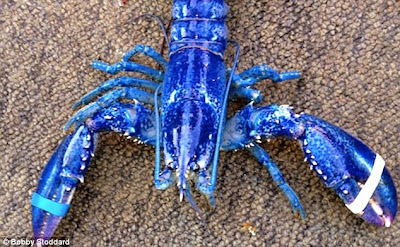 Rarity: A rare blue lobster, pictured, was caught last month off the Canadian coast in a one-in-two million find thanks to a naturally excessive amount of a particular protein
Rarity: A rare blue lobster, pictured, was caught last month off the Canadian coast in a one-in-two million find thanks to a naturally excessive amount of a particular proteinIt's said to be a one-in-two-million chance of catching a lobster with a royal blue shell.
For lobster boat captain Bobby Stoddard, 51, of Nova Scotia, who has spent the last 33 years fishing at sea, that exquisite catch came last month.
Hauling in his traps in early May, Mr Stoddard recalled the curious call sent out by one of his crew members:
'Hey, we got a pretty one in this trap!' Mr Stoddard told CNN.
'I turned around and said, "Holy Smokes!"
The 1.5lbs crustacean, found too unique by Mr Stoddard to eat, is coloured by a rare genetic variation according to researchers at the University of Maine Lobster Institute.
 Ordinary: Prior to being cooked and turning red, most lobsters are found in browns and dark greens, as seen in this file photo of them removed from a cage at sea
Ordinary: Prior to being cooked and turning red, most lobsters are found in browns and dark greens, as seen in this file photo of them removed from a cage at sea'The coloration comes from a genetic defect that causes the lobster to produce an excessive amount of a particular protein that gives the lobster that unique coloration,' the Lobster Institute states.
Normally appearing brown or dark green in nature prior to boiling, and first considered 'garbage' food given to peasants during the 17th and 18th century according to the Institute, lobsters have been found in even more rare colours than blue.
 Natural reds: Even more rare than blue lobsters are red lobsters which are found this color, pictured, in one out of 10 million before being cooked
Natural reds: Even more rare than blue lobsters are red lobsters which are found this color, pictured, in one out of 10 million before being cooked Comparison: This red lobster, pictured beside a regular brown one, was caught off Maine in 2010
Comparison: This red lobster, pictured beside a regular brown one, was caught off Maine in 2010According to the Gulf of Maine Research Institute, one-out-of-10 million lobsters are found in a bright red colour.
Even rarer, however, are yellow and calico lobsters - speckled with yellows and oranges - which both have an estimated one-in-30 million chance of finding.
While having much greater odds of catching a blue lobster, than a red or yellow one, Mr Stoddard said - despite hauling in about 3,000 lobsters on a good day - this was the first blue one he has personally ever seen.
'Even overtop his eyes and underneath, he's just really blue,' he told CBC News.
Unsure what to do with his new find, Mr Stoddard said he placed the animal in a tank at his business and then on an online auction after a suggestion by his girlfriend, at a starting bid of $200.
 Rarest: A calico lobster at the New England Aquarium is pictured which are found in one-out-of 30 million
Rarest: A calico lobster at the New England Aquarium is pictured which are found in one-out-of 30 million
Yellow: This yellow lobster, like the calico, has a one-in-30 million chance of being found, as seen at Massachusetts' New England Aquarium
'I wanted to put a number high enough on it so nobody would be interested in it,' Mr Stoddard later admitted to CNN.
Changing his mind after some hassle for attempting to sell the lobster, he offered it to the Bedford Institute of Oceanography but they had no interest.
'I don't know what the best thing is to do,' he told CNN. 'It probably belongs back in the ocean, but I'd like for as many people as possible to see it.'
He promises that he'd faster throw it back in the ocean than allow anyone to eat it, however.
In 2010, the BBC reports a fisherman in Rhode Island catching one of the rare yellow lobsters, opting to display his find in a fishermen co-op in Newport.
source :dailymail














